Are you a professional
Download as ppt, pdf0 likes406 views
A farcical look at what it takes to be a professional. A quick quiz you can use for entertainment.
1 of 12
Download to read offline

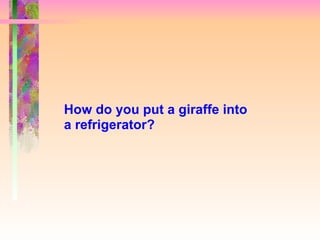
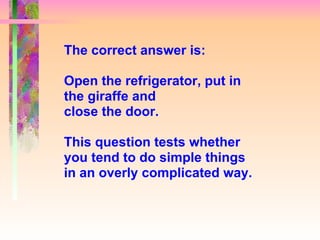
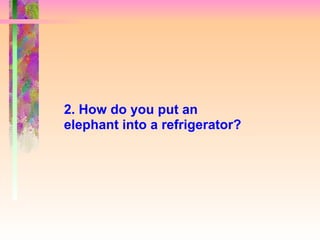

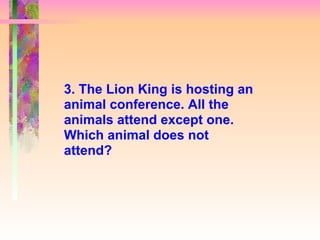
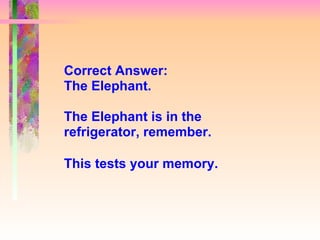
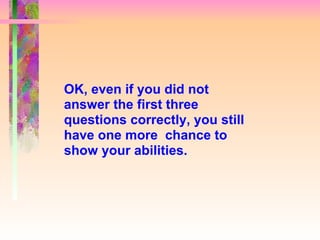
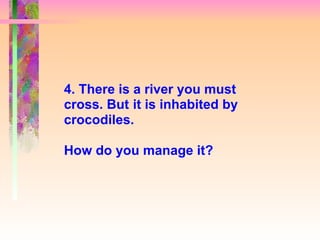
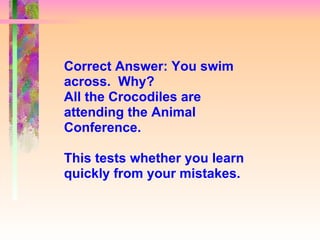
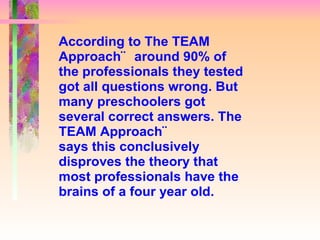

Ad
Recommended
キレイな姿势になるためのエクササイズ
キレイな姿势になるためのエクササイズjump2higher
?
スタイルリフォーマー 小林 俊夫による、姿勢をキレイにするエクササイズの解説をお届けします。
一人でも多くの女性にキレイになってもらえたらうれしいです。Last but not leastAlejandra Rotman
?
El documento habla sobre los últimos momentos y días de una persona en la escuela primaria, mencionando el último día de clases, la última entrega de diplomas, la última maestra y expresando que extra?arán a la persona.Pengenalan web minggu ketiga
Pengenalan web minggu ketigaWawan Darmawan
?
CSS digunakan untuk mengontrol tampilan halaman web yang dibuat dengan HTML dan XHTML. CSS dibagi menjadi tiga yaitu inline, internal, dan external style sheet. CSS memungkinkan pengaturan format teks, warna, ukuran, tata letak, dan gaya lainnya untuk membuat tampilan halaman web lebih rapi dan konsisten.Facilitating Online - 5 Easy Pieces
Facilitating Online - 5 Easy PiecesRick Stamm
?
The document outlines five key elements for effective online facilitation: culture shift, relevance of content, fostering interaction, monitoring expectations, and authenticity in presentation. It discusses the challenges and strategies in online learning, emphasizing the importance of engagement, support, and integration of online methods into organizational culture. Furthermore, it highlights the need for results and behavior change similar to that achieved in traditional classrooms.Cafe Draft
Cafe DraftRick Stamm
?
This document promotes a community of practice called the Team Leader Café that aims to help leaders grow professionally. The café offers connections, networking, problem solving, feedback and learning opportunities. Leaders can gain new ideas and insights from guest experts on topics relevant to their success and their organizations' success. The café also provides development tools like feedback filters, individual development planning, and additional services like coaching and training to help leaders refine their skills.Mysteries of Motivation
Mysteries of MotivationRick Stamm
?
The document discusses the principles of motivation, emphasizing that individuals are motivated by their own reasons rather than external pressures. It describes different behavioral styles, categorizing them into four types (D, I, S, C) and highlights the environments that motivate each type. The text concludes with a call for feedback and engagement regarding leadership development needs.20/20 Insight Demonstration
20/20 Insight DemonstrationRick Stamm
?
20/20 Insight is a flexible and economical 360-degree feedback tool that can be used for individuals, teams, and organizations. It has a large library of survey items and templates that are easy to customize. The dashboard allows for intuitive project setup, survey distribution, and generation of multiple levels of reports. Technical support is also provided to help users get the most out of the system.Aiuve exercise
Aiuve exercisekazuaki imai
?
AIUVE excercise correct mouth breath and heal ann iiiness allergic disease(bronchial asthma,allregic rhinitis more), inflammatory bowei disease(Ulcerative colitis , Crohn's disease more), collagen disease(rhumatoid arthritis more).
Its very simple and easy for evyryone.Ivaldoldpres
Ivaldoldpresbkilbane
?
The document discusses techniques for managing loss of rotation with reverse shoulder prostheses. It presents strategies for improving both internal and external rotation. It also describes a surgical technique for transferring the latissimus dorsi muscle to help increase active external rotation, including advantages of this approach. Post-operative results of reverse prostheses both with and without latissimus dorsi transfer are shown, demonstrating improved external rotation when combined with the muscle transfer.Indications and tecniques for reverse prosthesys (RSA) on fractures
Indications and tecniques for reverse prosthesys (RSA) on fracturesbaudispallaonline
?
This document discusses the indications and outcomes of reverse shoulder arthroplasty (RSA) versus hemiarthroplasty (HA) for treating complex proximal humeral fractures, especially in elderly patients. RSA is shown to provide more reliable and predictable functional results compared to HA, particularly in patients aged 65 to 75, as it yields better range of motion and strength recovery. The study emphasizes the importance of RSA in specific cases, such as those with osteoporotic bone, multiple fragments, or associated cuff tears.The Optimal Patient-Specific Placement of the Reverse Shoulder Component
The Optimal Patient-Specific Placement of the Reverse Shoulder ComponentSven Delport
?
This document summarizes a study on optimizing the placement of reverse shoulder arthroplasty components through computer simulation. The study aims to analyze how component placement and design affect range of motion and adduction deficit. The simulation software allows inputting patient-specific anatomy and implant data to test different component sizes, orientations, and designs. Preliminary results show superior range of motion and adduction with lateralized and inferiorly positioned glenospheres, and retroversion angles between 15-30 degrees. Future work includes validating simulations with clinical data and testing additional component designs.MyEverythingDiSC
MyEverythingDiSCRick Stamm
?
Kari receives access to MyEverythingDiSC after completing an Everything DiSC assessment. She explores the various features, including comparing her DiSC style to teammates, creating a group map of her project team, learning about her own style profile, and setting up her account preferences. The document provides a guided overview of the key capabilities in MyEverythingDiSC for personalized DiSC learning.363 Orientation
363 OrientationRick Stamm
?
This document provides an overview of a 360 assessment process and report for leadership development. It outlines a clear process for leaders to receive anonymous feedback from managers, direct reports, peers, and others. The report includes a leader's DiSC profile, how raters see the leader across eight leadership approaches, self vs. rater comparisons, strengths identified by raters, and personalized development strategies. Raters can provide anonymous comments through a "CommentSmart" feature. The goal is to provide leaders with meaningful feedback to improve their effectiveness in a supported coaching process.Evolution of DiSC
Evolution of DiSCRick Stamm
?
The document outlines the evolution of the DISC assessment since 1986, detailing developments in theory, assessment methods, and reporting styles across various personalities. It introduces the Everything DiSC assessment, which uses adaptive testing to maximize precision and personalized feedback, resulting in improved accuracy and reliability over previous models. The text also highlights the introduction of product-specific measurement and unique assessment items tailored to individual profiles.Introducing Everything DiSC
Introducing Everything DiSCRick Stamm
?
The document outlines the Everything DiSC assessment tools aimed at enhancing workplace dynamics by helping individuals understand their behavioral styles and how to adapt to others. It features applications in sales, management, and workplace relationships, emphasizing personalized feedback and adaptive testing to improve communication, engagement, and effectiveness. Additionally, the document discusses research findings and participant feedback related to the tools' effectiveness in real-world scenarios.MyEverythingDiSC.com
MyEverythingDiSC.comRick Stamm
?
MyEverythingDiSC.com allows users to gain insights about their DiSC style and compare styles with others. Kari receives access after taking a DiSC assessment and creates an account. She explores her DiSC style and map, views her full profile report, and sets her account preferences. Kari then creates customer and team maps to compare her style with others, view tips, and better understand how to work with different styles. The platform provides ongoing DiSC learning through various tools and can be accessed anywhere through mobile devices.More Related Content
Viewers also liked (17)
Aiuve exercise
Aiuve exercisekazuaki imai
?
AIUVE excercise correct mouth breath and heal ann iiiness allergic disease(bronchial asthma,allregic rhinitis more), inflammatory bowei disease(Ulcerative colitis , Crohn's disease more), collagen disease(rhumatoid arthritis more).
Its very simple and easy for evyryone.Ivaldoldpres
Ivaldoldpresbkilbane
?
The document discusses techniques for managing loss of rotation with reverse shoulder prostheses. It presents strategies for improving both internal and external rotation. It also describes a surgical technique for transferring the latissimus dorsi muscle to help increase active external rotation, including advantages of this approach. Post-operative results of reverse prostheses both with and without latissimus dorsi transfer are shown, demonstrating improved external rotation when combined with the muscle transfer.Indications and tecniques for reverse prosthesys (RSA) on fractures
Indications and tecniques for reverse prosthesys (RSA) on fracturesbaudispallaonline
?
This document discusses the indications and outcomes of reverse shoulder arthroplasty (RSA) versus hemiarthroplasty (HA) for treating complex proximal humeral fractures, especially in elderly patients. RSA is shown to provide more reliable and predictable functional results compared to HA, particularly in patients aged 65 to 75, as it yields better range of motion and strength recovery. The study emphasizes the importance of RSA in specific cases, such as those with osteoporotic bone, multiple fragments, or associated cuff tears.The Optimal Patient-Specific Placement of the Reverse Shoulder Component
The Optimal Patient-Specific Placement of the Reverse Shoulder ComponentSven Delport
?
This document summarizes a study on optimizing the placement of reverse shoulder arthroplasty components through computer simulation. The study aims to analyze how component placement and design affect range of motion and adduction deficit. The simulation software allows inputting patient-specific anatomy and implant data to test different component sizes, orientations, and designs. Preliminary results show superior range of motion and adduction with lateralized and inferiorly positioned glenospheres, and retroversion angles between 15-30 degrees. Future work includes validating simulations with clinical data and testing additional component designs.More from Rick Stamm (15)
MyEverythingDiSC
MyEverythingDiSCRick Stamm
?
Kari receives access to MyEverythingDiSC after completing an Everything DiSC assessment. She explores the various features, including comparing her DiSC style to teammates, creating a group map of her project team, learning about her own style profile, and setting up her account preferences. The document provides a guided overview of the key capabilities in MyEverythingDiSC for personalized DiSC learning.363 Orientation
363 OrientationRick Stamm
?
This document provides an overview of a 360 assessment process and report for leadership development. It outlines a clear process for leaders to receive anonymous feedback from managers, direct reports, peers, and others. The report includes a leader's DiSC profile, how raters see the leader across eight leadership approaches, self vs. rater comparisons, strengths identified by raters, and personalized development strategies. Raters can provide anonymous comments through a "CommentSmart" feature. The goal is to provide leaders with meaningful feedback to improve their effectiveness in a supported coaching process.Evolution of DiSC
Evolution of DiSCRick Stamm
?
The document outlines the evolution of the DISC assessment since 1986, detailing developments in theory, assessment methods, and reporting styles across various personalities. It introduces the Everything DiSC assessment, which uses adaptive testing to maximize precision and personalized feedback, resulting in improved accuracy and reliability over previous models. The text also highlights the introduction of product-specific measurement and unique assessment items tailored to individual profiles.Introducing Everything DiSC
Introducing Everything DiSCRick Stamm
?
The document outlines the Everything DiSC assessment tools aimed at enhancing workplace dynamics by helping individuals understand their behavioral styles and how to adapt to others. It features applications in sales, management, and workplace relationships, emphasizing personalized feedback and adaptive testing to improve communication, engagement, and effectiveness. Additionally, the document discusses research findings and participant feedback related to the tools' effectiveness in real-world scenarios.MyEverythingDiSC.com
MyEverythingDiSC.comRick Stamm
?
MyEverythingDiSC.com allows users to gain insights about their DiSC style and compare styles with others. Kari receives access after taking a DiSC assessment and creates an account. She explores her DiSC style and map, views her full profile report, and sets her account preferences. Kari then creates customer and team maps to compare her style with others, view tips, and better understand how to work with different styles. The platform provides ongoing DiSC learning through various tools and can be accessed anywhere through mobile devices.Orientation to DiSC 363 for Leaders
Orientation to DiSC 363 for LeadersRick Stamm
?
The document outlines a comprehensive approach to 360-degree assessments focusing on leadership development. It emphasizes strategies for gathering feedback from various respondents and highlights a structured process for leaders to understand their strengths and areas for improvement. Additionally, it details the timeline and resources available for participants to engage with the assessment and coaching process.Creative Problem Solving
Creative Problem SolvingRick Stamm
?
The document outlines a collaborative team approach to problem-solving, emphasizing creativity and fun while working on challenges. It details key brainstorming techniques, a structured problem-solving process, and emphasizes the importance of defining problems clearly. Additionally, it highlights the need to unlearn limiting beliefs to enhance creativity and provides examples to stimulate innovative thinking.Conflict magic
Conflict magicRick Stamm
?
The document discusses conflict in interpersonal relationships, highlighting that differences are inevitable due to varying behaviors and needs. It outlines different modes of conflict resolution, including competing, accommodating, avoiding, compromising, and collaborating, emphasizing the importance of understanding each other's perspectives. The document also provides strategies for resolving conflicts effectively and maintaining positive relationships.Orientation for DiSC 363 Project
Orientation for DiSC 363 ProjectRick Stamm
?
The document describes Everything DiSC 363, a 360-degree feedback tool that combines assessments of leadership styles and behaviors with personalized development strategies; it outlines the process for leaders and raters to complete assessments and receive reports that highlight strengths, opportunities for improvement, and customized action plans based on the DiSC model of leadership. The goal of Everything DiSC 363 is to provide more constructive 360-degree feedback that leaders can easily understand and apply to become more effective.360 Feedback Briefing for Subjects
360 Feedback Briefing for SubjectsRick Stamm
?
The document outlines an agenda for a 360 feedback session, focusing on receiving and sharing feedback, developing competencies, and self-development strategies. It includes guidelines for both giving and receiving feedback, understanding reactions to feedback, and analyzing feedback reports. Additionally, it provides tools and strategies for personal performance analysis and goal setting to improve professional development.360 Feedback Orientation Template
360 Feedback Orientation TemplateRick Stamm
?
The document outlines a 360-degree feedback process designed to enhance individual and team performance within an organization. It emphasizes the importance of behavior-based competencies, anonymity in feedback collection, and the use of surveys to inform development plans while addressing common pitfalls in providing and receiving feedback. The process aims to foster a culture of communication and constructive criticism to facilitate professional growth and teamwork.Marshmallow Challenge
Marshmallow ChallengeRick Stamm
?
The Marshmallow Challenge requires teams to build the tallest freestanding structure using provided materials, with the marshmallow placed entirely on top. Participants cannot use any part of the structure for support and must complete the challenge in 18 minutes. Any cutting of the marshmallow disqualifies the team, while they are free to alter provided materials like spaghetti, string, and tape.Priorities
PrioritiesRick Stamm
?
The Goals & Priorities Action Planning Seminar held on March 23, 2009, aimed to provide tools for effective time management and help participants enhance productivity at work, school, and home. Key topics included the importance of setting SMART goals and the impact of attitude on managing time effectively. The seminar also encouraged participants to establish new habits and prioritize tasks based on urgency and importance.Become a Team of Choice
Become a Team of ChoiceRick Stamm
?
The document outlines a comprehensive process for building an effective team by emphasizing goal alignment, open communication, trust, and continuous improvement. It details steps including team assessments, identifying individual strengths, and promoting development through structured feedback and training. The aim is to foster creativity, collaboration, and commitment, ultimately creating a high-performing team environment.Train to Ingrain Presentation
Train to Ingrain PresentationRick Stamm
?
The survey results show that the company needs improvement in developing leaders and supporting employee development. Less than half of employees feel the company identifies and develops high performers (46%) or has processes to ensure future leaders (36%). Even fewer agree that supervisors have the skills to support direct reports' development (29%) or effectively resolve workplace conflicts (43%). Only 38% feel supervisors communicate expectations well. The document discusses challenges with transferring training to on-the-job performance. There is often a lack of accountability and follow-up after training. Long-term behavior change requires ongoing reinforcement through activities like follow-up discussions, support groups, and feedback from managers.Ad
Recently uploaded (20)
Jordan Minnesota - The Town Where Your Diet Comes to Die
Jordan Minnesota - The Town Where Your Diet Comes to DieForklift Trucks in Minnesota
?
You ever try to pick a place to eat in Jordan, Minnesota? It’s like being dropped in the middle of a delicious labyrinth with no map, no compass, and way too many good smells coming from all directions. One minute you’re thinking, “Eh, I’ll just grab something quick,” and the next thing you know, you’re halfway through a plate of brisket that tastes like it was slow-cooked by angels and blessed by a pitmaster with a doctorate in flavor.
Pizza? They've got enough cheesy, crusty goodness to start a small but passionate fan club. Tacos? Yes, please—and not the kind that fall apart the second you look at them sideways. We're talking hand-held miracles. Craving something sweet? Boom—bakery case. Cookies the size of your face, pies that look like they should be in a museum, and cupcakes that actually spark joy.
There’s no “just grab a bite” in Jordan. You either commit to the flavor adventure or get out of the way. Trying to decide where to go is like arguing with your stomach in five languages. It's not a question of if you'll find something good—it’s how many meals you can fit into one afternoon without needing a forklift to get back to your car.最新版美国堪萨斯州立大学毕业证(碍-厂迟补迟别毕业证书)原版定制
最新版美国堪萨斯州立大学毕业证(碍-厂迟补迟别毕业证书)原版定制taqyea
?
一比一还原堪萨斯州立大学毕业证/K-State毕业证书2025原版【q薇1954292140】我们专业办理澳洲大学毕业证成绩单,美国大学毕业证成绩单,英国大学毕业证成绩单,加拿大大学毕业证成绩单,新加坡大学毕业证成绩单,新西兰大学毕业证成绩单,韩国大学毕业证成绩单,日本大学毕业证成绩单。
【复刻一套堪萨斯州立大学毕业证成绩单信封等材料最强攻略,Buy Kansas State University Transcripts】
购买日韩成绩单、英国大学成绩单、美国大学成绩单、澳洲大学成绩单、加拿大大学成绩单(q微1954292140)新加坡大学成绩单、新西兰大学成绩单、爱尔兰成绩单、西班牙成绩单、德国成绩单。成绩单的意义主要体现在证明学习能力、评估学术背景、展示综合素质、提高录取率,以及是作为留信认证申请材料的一部分。
堪萨斯州立大学成绩单能够体现您的的学习能力,包括堪萨斯州立大学课程成绩、专业能力、研究能力。(q微1954292140)具体来说,成绩报告单通常包含学生的学习技能与习惯、各科成绩以及老师评语等部分,因此,成绩单不仅是学生学术能力的证明,也是评估学生是否适合某个教育项目的重要依据!
我们承诺采用的是学校原版纸张(原版纸质、底色、纹路)我们工厂拥有全套进口原装设备,特殊工艺都是采用不同机器制作,仿真度基本可以达到100%,所有成品以及工艺效果都可提前给客户展示,不满意可以根据客户要求进行调整,直到满意为止!
【主营项目】
一、工作未确定,回国需先给父母、亲戚朋友看下文凭的情况,办理毕业证|办理文凭: 买大学毕业证|买大学文凭【q薇1954292140】堪萨斯州立大学学位证明书如何办理申请?
二、回国进私企、外企、自己做生意的情况,这些单位是不查询毕业证真伪的,而且国内没有渠道去查询国外文凭的真假,也不需要提供真实教育部认证。鉴于此,办理美国成绩单堪萨斯州立大学毕业证【q薇1954292140】国外大学毕业证, 文凭办理, 国外文凭办理, 留信网认证
三.材料咨询办理、认证咨询办理请加学历顾问【微信:1954292140】堪萨斯州立大学毕业证购买指大学文凭购买,毕业证办理和文凭办理。学院文凭定制,学校原版文凭补办,扫描件文凭定做,100%文凭复刻。The Bet - Concept Teaser v06 Storyboards
The Bet - Concept Teaser v06 StoryboardsJim Mortensen
?
"THE BET" : God & the Devil wagering on which one of them is better at convincing a family to stick with them despite ruining their lives on a daily basis.仿制颁厂鲍厂学费单美国加利福尼亚州立大学萨克拉门托分校毕业证范本,颁厂鲍厂文凭
仿制颁厂鲍厂学费单美国加利福尼亚州立大学萨克拉门托分校毕业证范本,颁厂鲍厂文凭taqyed
?
鉴于此,办理CSUS大学毕业证加利福尼亚州立大学萨克拉门托分校毕业证书【q薇1954292140】留学一站式办理学历文凭直通车(加利福尼亚州立大学萨克拉门托分校毕业证CSUS成绩单原版加利福尼亚州立大学萨克拉门托分校学位证假文凭)未能正常毕业?【q薇1954292140】办理加利福尼亚州立大学萨克拉门托分校毕业证成绩单/留信学历认证/学历文凭/使馆认证/留学回国人员证明/录取通知书/Offer/在读证明/成绩单/网上存档永久可查!
如果您处于以下几种情况:
◇在校期间,因各种原因未能顺利毕业……拿不到官方毕业证
◇面对父母的压力,希望尽快拿到;
◇不清楚认证流程以及材料该如何准备;
◇回国时间很长,忘记办理;
◇回国马上就要找工作,办给用人单位看;
◇企事业单位必须要求办理的
◇需要报考公务员、购买免税车、落转户口
◇申请留学生创业基金
【办理加利福尼亚州立大学萨克拉门托分校成绩单Buy California State University, Sacramento Transcripts】
购买日韩成绩单、英国大学成绩单、美国大学成绩单、澳洲大学成绩单、加拿大大学成绩单(q微1954292140)新加坡大学成绩单、新西兰大学成绩单、爱尔兰成绩单、西班牙成绩单、德国成绩单。成绩单的意义主要体现在证明学习能力、评估学术背景、展示综合素质、提高录取率,以及是作为留信认证申请材料的一部分。
加利福尼亚州立大学萨克拉门托分校成绩单能够体现您的的学习能力,包括加利福尼亚州立大学萨克拉门托分校课程成绩、专业能力、研究能力。(q微1954292140)具体来说,成绩报告单通常包含学生的学习技能与习惯、各科成绩以及老师评语等部分,因此,成绩单不仅是学生学术能力的证明,也是评估学生是否适合某个教育项目的重要依据!在线购买西班牙毕业证安东尼奥·德·内夫里哈大学文凭鲍础狈贰学费单
在线购买西班牙毕业证安东尼奥·德·内夫里哈大学文凭鲍础狈贰学费单Taqyea
?
1:1原版安东尼奥·德·内夫里哈大学毕业证+UANE成绩单【Q微:1954 292 140】鉴于此,UANEdiploma安东尼奥·德·内夫里哈大学挂科处理解决方案UANE毕业证成绩单专业服务学历认证【Q微:1954 292 140】办理教育部学历认证,留学回国证明,安东尼奥·德·内夫里哈大学毕业证、安东尼奥·德·内夫里哈大学成绩单、安东尼奥·德·内夫里哈大学文凭(留信学历认证+永久存档查询)办理本科+硕士+博士毕业证成绩单学历认证,我们一直是留学生的首选,质量行业第一,诚信可靠。
【安东尼奥·德·内夫里哈大学成绩单一站式办理专业技术完美呈现Universidad Antonio de Nebrija Transcripts】
购买日韩成绩单、英国大学成绩单、美国大学成绩单、澳洲大学成绩单、加拿大大学成绩单(q微1954292140)新加坡大学成绩单、新西兰大学成绩单、爱尔兰成绩单、西班牙成绩单、德国成绩单。成绩单的意义主要体现在证明学习能力、评估学术背景、展示综合素质、提高录取率,以及是作为留信认证申请材料的一部分。
安东尼奥·德·内夫里哈大学成绩单能够体现您的的学习能力,包括安东尼奥·德·内夫里哈大学课程成绩、专业能力、研究能力。(q微1954292140)具体来说,成绩报告单通常包含学生的学习技能与习惯、各科成绩以及老师评语等部分,因此,成绩单不仅是学生学术能力的证明,也是评估学生是否适合某个教育项目的重要依据!
【主营项目】
一.毕业证【q微1954292140】成绩单、使馆认证、教育部认证、雅思托福成绩单、学生卡等!
二.真实使馆公证(即留学回国人员证明,不成功不收费)
三.真实教育部学历学位认证(教育部存档!教育部留服网站永久可查)
四.办理各国各大学文凭(一对一专业服务,可全程监控跟踪进度)burstone analysis.pptx..........................................................
burstone analysis.pptx..........................................................UjjawalKrishnan
?
hjgghgbcvRice Genomics & Whole Genome Sequencing.pptx
Rice Genomics & Whole Genome Sequencing.pptxLikhithHR
?
This presentation delves into the fascinating journey of rice genomics and whole genome sequencing, charting the evolution from early marker development to cutting-edge genome editing and pan-genomics. Rice (Oryza sativa) is not only a staple crop feeding over half the global population but also a model organism for cereal genomics due to its relatively small genome, rich genetic diversity, and high synteny with other grasses like wheat and maize. The presentation outlines why rice was the first crop plant to be fully sequenced and traces the contributions of international consortia such as IRGSP, Syngenta, and Monsanto, along with India’s role in sequencing chromosome 11 through the Indian Initiative for Rice Genome Sequencing (IIRGS). Detailed insights are provided into map-based sequencing methods, clone-by-clone strategies, and hierarchical shotgun sequencing, including how BAC and PAC libraries enabled high-quality genome assemblies. The sequencing of Nipponbare (japonica) laid the foundation for comprehensive rice genome annotation, revealing over 37,000 coding genes, extensive gene duplications, and a high density of transposable elements. The presentation explores the impact of rice genomic data on the development of molecular markers (SSRs, SNPs, InDels, ILPs), comparative genomics, structural and functional annotation, and custom-made markers for precision breeding. Advances post-genome era, including the 3K Rice Genome Project and updates in the Rice Genome Annotation Project (RGAP), are discussed along with emerging tools like pan-genomics, synteny maps, and RNA-seq-based expression profiling. Special attention is given to the sequencing and functional relevance of rice mitochondrial and chloroplast genomes, which play roles in energy metabolism, cytoplasmic male sterility, and hybrid breeding. Recent breakthroughs such as the activation of BBM1 and WOX9A genes for clonal seed development highlight the potential of synthetic apomixis. The talk concludes with reflections on the transformative impact of rice genome sequencing on crop improvement, enabling breeders to enhance yield, stress resilience, and nutritional quality through genomics-assisted selection and genome editing. This presentation serves as a comprehensive guide for students, researchers, and breeders navigating the landscape of rice genomics in the era of precision agricultureStrategy & Survival in Aliens Another Glorious Day in the Corps!
Strategy & Survival in Aliens Another Glorious Day in the Corps!BoardGamesNMore
?
Dive into the high-stakes world of Aliens: Another Glorious Day in the Corps! This PPT explores key strategies, survival tips, and co-op mechanics that make this game a must-play for sci-fi and board game enthusiasts. Perfect for fans of tactical teamwork!Ralf Schumacher_ The Shadow and the Spotlight in Formula One.docx
Ralf Schumacher_ The Shadow and the Spotlight in Formula One.docxvoice ofarticle
?
When the conversation turns to the most iconic names in the high-octane world of Formula One, it’s impossible to ignore the Schumacher legacy. While Michael Schumacher’s record-breaking career often takes center stage, his younger brother, Ralf Schumacher, has crafted a compelling and impressive racing story of his own — one that deserves to be told in full. Often introduced in the shadow of his elder sibling, Ralf refused to remain just "Michael's younger brother" for long. Instead, he emerged as a fierce competitor with raw talent, relentless determination, and a deep passion for racing that was evident from a very young age.
Growing up in the motorsport-rich environment of Germany, Ralf Schumacher began his racing journey on the local karting circuits, where he quickly displayed a natural flair for speed and control. It was here that he honed the skills that would one day propel him onto the world stage. Unlike many young drivers who fizzle out before reaching the top, Ralf steadily climbed the ranks, moving from national championships to the international arena with precision and maturity far beyond his years. His early years were marked by countless hours of training, setbacks that tested his resolve, and victories that fueled his ambition.
最新版美国堪萨斯大学毕业证(碍鲍毕业证书)原版定制
最新版美国堪萨斯大学毕业证(碍鲍毕业证书)原版定制taqyea
?
一比一还原堪萨斯大学毕业证/KU毕业证书2025原版【q薇1954292140】我们专业办理澳洲大学毕业证成绩单,美国大学毕业证成绩单,英国大学毕业证成绩单,加拿大大学毕业证成绩单,新加坡大学毕业证成绩单,新西兰大学毕业证成绩单,韩国大学毕业证成绩单,日本大学毕业证成绩单。
【复刻一套堪萨斯大学毕业证成绩单信封等材料最强攻略,Buy The University of Kansas Transcripts】
购买日韩成绩单、英国大学成绩单、美国大学成绩单、澳洲大学成绩单、加拿大大学成绩单(q微1954292140)新加坡大学成绩单、新西兰大学成绩单、爱尔兰成绩单、西班牙成绩单、德国成绩单。成绩单的意义主要体现在证明学习能力、评估学术背景、展示综合素质、提高录取率,以及是作为留信认证申请材料的一部分。
堪萨斯大学成绩单能够体现您的的学习能力,包括堪萨斯大学课程成绩、专业能力、研究能力。(q微1954292140)具体来说,成绩报告单通常包含学生的学习技能与习惯、各科成绩以及老师评语等部分,因此,成绩单不仅是学生学术能力的证明,也是评估学生是否适合某个教育项目的重要依据!
我们承诺采用的是学校原版纸张(原版纸质、底色、纹路)我们工厂拥有全套进口原装设备,特殊工艺都是采用不同机器制作,仿真度基本可以达到100%,所有成品以及工艺效果都可提前给客户展示,不满意可以根据客户要求进行调整,直到满意为止!
【主营项目】
一、工作未确定,回国需先给父母、亲戚朋友看下文凭的情况,办理毕业证|办理文凭: 买大学毕业证|买大学文凭【q薇1954292140】堪萨斯大学学位证明书如何办理申请?
二、回国进私企、外企、自己做生意的情况,这些单位是不查询毕业证真伪的,而且国内没有渠道去查询国外文凭的真假,也不需要提供真实教育部认证。鉴于此,办理美国成绩单堪萨斯大学毕业证【q薇1954292140】国外大学毕业证, 文凭办理, 国外文凭办理, 留信网认证
三.材料咨询办理、认证咨询办理请加学历顾问【微信:1954292140】堪萨斯大学毕业证购买指大学文凭购买,毕业证办理和文凭办理。学院文凭定制,学校原版文凭补办,扫描件文凭定做,100%文凭复刻。Breaking the Romance Narrative – Why I Wrote “Hello”
Breaking the Romance Narrative – Why I Wrote “Hello”itstriggerhere
?
? Hello isn’t just another Telugu R&B track.
It’s a rebellion wrapped in melody. A conversation I’ve had with love, boundaries, and personal freedom.
As a music producer and artist, I’ve always felt stuck between two extremes — either glorify love or completely reject it.
But what if we showed the grey?
The emotional chaos? The unapologetic detachment?
"Hello" is for everyone who’s tired of being boxed in — the bad boys, the misunderstood ones, the ones who choose themselves.
The lyrics touch on:
Romantic fatigue
Sarcastic surrender
Self-realization
Hyper-masculinity vs vulnerability
All layered with smooth hip hop and R&B textures.
? Listen to it, and you'll either judge me or feel seen.
Either way, the conversation starts here.
Let’s normalize songs that don’t glorify suffering in love.
Let’s talk about freedom.
Let’s challenge tropes.
Drop your bias. Play the song.
Hello out July 11.
@itstriggerhere — Musician. Disruptor. Storyteller.Season 12 _ EP 01 _ Lieutenant Quiz.pptx
Season 12 _ EP 01 _ Lieutenant Quiz.pptxQuiz Club, Indian Institute of Technology, Patna
?
Weekly quiz conducted as part of season 12The Bet - Concept Teaser v06 Storyboards
The Bet - Concept Teaser v06 StoryboardsJim Mortensen
?
"THE BET" : God & the Devil wagering on which one of them is better at convincing a family to stick with them despite ruining their lives on a daily basis.Season 12 _ EP03 - The Coked up Quiz .pdf
Season 12 _ EP03 - The Coked up Quiz .pdfQuiz Club, Indian Institute of Technology, Patna
?
Weekly set conducted as part of season 12.原版一样(滨奥鲍毕业证书)美国印第安纳卫斯里大学毕业证在线购买
原版一样(滨奥鲍毕业证书)美国印第安纳卫斯里大学毕业证在线购买taqyed
?
鉴于此,办理IWU大学毕业证印第安纳卫斯里大学毕业证书【q薇1954292140】留学一站式办理学历文凭直通车(印第安纳卫斯里大学毕业证IWU成绩单原版印第安纳卫斯里大学学位证假文凭)未能正常毕业?【q薇1954292140】办理印第安纳卫斯里大学毕业证成绩单/留信学历认证/学历文凭/使馆认证/留学回国人员证明/录取通知书/Offer/在读证明/成绩单/网上存档永久可查!
如果您处于以下几种情况:
◇在校期间,因各种原因未能顺利毕业……拿不到官方毕业证
◇面对父母的压力,希望尽快拿到;
◇不清楚认证流程以及材料该如何准备;
◇回国时间很长,忘记办理;
◇回国马上就要找工作,办给用人单位看;
◇企事业单位必须要求办理的
◇需要报考公务员、购买免税车、落转户口
◇申请留学生创业基金
【办理印第安纳卫斯里大学成绩单Buy Indiana Wesleyan University Transcripts】
购买日韩成绩单、英国大学成绩单、美国大学成绩单、澳洲大学成绩单、加拿大大学成绩单(q微1954292140)新加坡大学成绩单、新西兰大学成绩单、爱尔兰成绩单、西班牙成绩单、德国成绩单。成绩单的意义主要体现在证明学习能力、评估学术背景、展示综合素质、提高录取率,以及是作为留信认证申请材料的一部分。
印第安纳卫斯里大学成绩单能够体现您的的学习能力,包括印第安纳卫斯里大学课程成绩、专业能力、研究能力。(q微1954292140)具体来说,成绩报告单通常包含学生的学习技能与习惯、各科成绩以及老师评语等部分,因此,成绩单不仅是学生学术能力的证明,也是评估学生是否适合某个教育项目的重要依据!Season 12_EP02 - Quiz Quiz Hota Hai.pptx
Season 12_EP02 - Quiz Quiz Hota Hai.pptxQuiz Club, Indian Institute of Technology, Patna
?
Weekly set conducted as part of season 12.Ad
